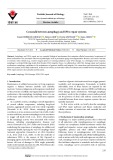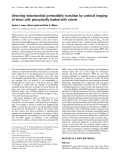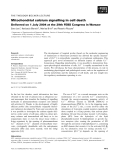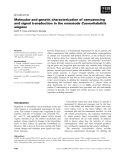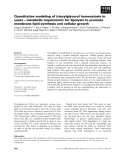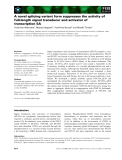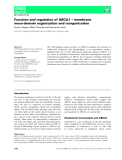
Cellular homeostasis
-
Autophagy and DNA repair are two essential biological mechanisms that maintain cellular homeostasis. Impairment of these mechanisms was associated with several pathologies such as premature aging, neurodegenerative diseases, and cancer. Intrinsic or extrinsic stress stimuli (e.g., reactive oxygen species or ionizing radiation) cause DNA damage. As a biological stress response, autophagy is activated following insults that threaten DNA integrity.
 18p
18p  thiencuuchu
thiencuuchu
 27-11-2021
27-11-2021
 11
11
 1
1
 Download
Download
-
When studiedin vitro, mitochondrial permeability transition (MPT) is associated with an increase in mitochondrial per-meability to solutes up to 1500 Da in mass and a loss of electrical potential difference across the inner mitochondrial membrane (Dwmit). The MPT has been implicated as being important in cellular calcium homeostasis, autophagy and cell death via necrosis and apoptosis.
 8p
8p  research12
research12
 23-04-2013
23-04-2013
 47
47
 3
3
 Download
Download
-
To sustain life mammals have an absolute and continual requirement for oxygen, which is necessary to produce energy for normal cell survival and growth. Hence, main-tainingoxygen homeostasis is a critical requirement and mammals have evolved a wide range of cellular and phy-siological responses to adapt to changes in oxygen avail-ability. In the past few years it has become evident that the transcriptional protein complex hypoxia-inducible factor (HIF) is a key regulator of these processes.
 10p
10p  tumor12
tumor12
 20-04-2013
20-04-2013
 35
35
 4
4
 Download
Download
-
The development of targeted probes (based on the molecular engineering of luminescent or fluorescent proteins) has allowed the specific measure-ment of [Ca 2+ ] in intracellular organelles or cytoplasmic subdomains. This approach gave novel information on different aspects of cellular Ca 2+ homeostasis. Regarding mitochondria, it was possible to demonstrate that, upon physiological stimulation of cells, Ca 2+ is rapidly accumulated in the matrix.
 10p
10p  fptmusic
fptmusic
 11-04-2013
11-04-2013
 41
41
 2
2
 Download
Download
-
Adaptations of the kinetic properties of mitochondria in striated muscle lacking cytosolic (M) and⁄or mitochondrial (Mi) creatine kinase (CK) iso-forms in comparison to wild-type (WT) were investigated in vitro. Intact mitochondria were isolated from heart and gastrocnemius muscle of WT and single- and double CK-knock-out mice strains (cytosolic (M-CK –⁄ – ), mitochondrial (Mi-CK –⁄ – ) and double knock-out (MiM-CK –⁄ – ), respect-ively).
 10p
10p  awards
awards
 05-04-2013
05-04-2013
 40
40
 5
5
 Download
Download
-
Osmotic homeostasis is a fundamental requirement for life. In general, the effector mechanisms that mediate cellular and extracellular osmoregulation in animals are reasonably well defined. However, at the molecular level, little is known about how animals detect osmotic and ionic perturbations and transduce them into regulatory responses.
 8p
8p  media19
media19
 04-03-2013
04-03-2013
 30
30
 2
2
 Download
Download
-
Triacylglycerol metabolism inSaccharomyces cerevisiae was analyzed quan-titatively using a systems biological approach. Cellular growth, glucose uptake and ethanol secretion were measured as a function of time and used as input for a dynamic flux-balance model.
 12p
12p  vinaphone15
vinaphone15
 28-02-2013
28-02-2013
 38
38
 4
4
 Download
Download
-
Signal transducers and activators of transcription (STATs) regulate a vari-ety of cellular functions, including differentiation and proliferation. STAT3 and STAT5 are known to play important roles in brain processes, such as energy homeostasis and neuronal development. We isolated a novel splicing variant ofSTAT5Afrom a cDNA library of the mouse brainstem.
 12p
12p  viettel02
viettel02
 20-02-2013
20-02-2013
 32
32
 4
4
 Download
Download
-
The ATP-binding cassette protein A1 (ABCA1) mediates the secretion of cellular-free cholesterol and phospholipids to an extracellular acceptor, apolipoprotein A-I, to form high-density lipoprotein. Because ABCA1 is a key factor in cholesterol homeostasis, elaborate transcriptional and post-transcriptional regulations of ABCA1 have evolved to maintain cholesterol homeostasis.
 14p
14p  cosis54
cosis54
 04-01-2013
04-01-2013
 60
60
 4
4
 Download
Download
-
Harrison's Internal Medicine Chapter 45. Azotemia and Urinary Abnormalities Azotemia and Urinary Abnormalities: Introduction Normal kidney functions occur through numerous cellular processes to maintain body homeostasis. Disturbances in any of these functions can lead to a constellation of abnormalities that may be detrimental to survival.
 8p
8p  ongxaemnumber1
ongxaemnumber1
 29-11-2010
29-11-2010
 86
86
 4
4
 Download
Download
CHỦ ĐỀ BẠN MUỐN TÌM








